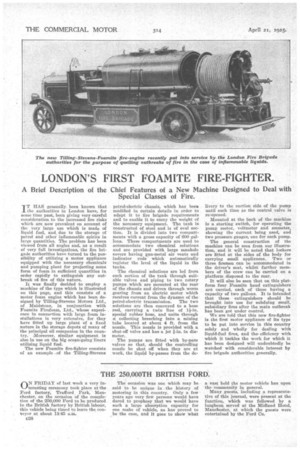LONDON'S FIRST FOAM1TE FIRE-FIGHTER.
Page 22

If you've noticed an error in this article please click here to report it so we can fix it.
A Brief Description of the Chief Features of a New Machine Designed to Deal with Special Classes of Fire.
IT HAS generally. been known that
the authorities in London have, for some time past, been giving very careful consideration to the increased fire risks which are now prevalent on account of the very large use which is made of liquid fuel, and due to the storage of petrol and other inflammable spirits in large quantities. The problem has been viewed from all angles and, as a result of very full investigations, the fire brigade authorities have turned to the possibility of utilizing a motor appliance equipped with the necessary chemicals and pumping plant for projecting some form of foam in sufficient quantities in order rapidly to extinguish any outbreak of fire of this nature.
It was finally decided to employ a machine of the type which is illustrated on this page, and this conaiste of a motor foam engine which has been designed by Tilling-Stevens Motors Ltd., of Maidstone, in conjunction with Foamite Firefoam, Ltd., 'whose experi. once in connection with large foam installations is very extensive, for they have fitted up large plant of a fixed nature in the storage depots of many of the principal oil companies in the country. Moreover, similar equipment is also in use on the big ocean:going, liners utilizing liquid fuel.
The new Foamite fire-fighter consists of an example of the Tilling-Stevens
petrol-electric chassis, which has been modified in certain details in order to adapt it to fire brigade requirements and to enable it to carry the weight of the necessary equipment. The tank is constructed of steel and is of oval section. It is divided into two compartments with a gross capacity of 600 gallons. These compartments are used to accommodate two chemical solutions and are provided with large manhole covers having gun-metal air vents and indicator rods which automatically register the level of the liquid in the tanks.
The chemical solutions are led from each section of the tank through suitable valves and piping to two rotary pumps which are mounted at the rear of the chassis and driven through worm gearing from an electric motor which receives current from the dynamo of the
petrol-electric transmission. The two solutions are then conveyed to a hose reel, carrying a twin line of 1.1-in, special rubber hose, and unite through a, collecting breeching into a mixing tube located at about 4 ft. from the nozzle. This nozzle is provided with a riraut-off valve and has a jet fin. in diameter..
The pumps are fitted with by-pass valves so that, should the controlling nozzle be shut off when they are at work, the liquid by-passes from the de
livery to the suction side of the pump until such time as the control valve is re-opened.
Mounted at the back of the machine is a starting switch, for operating the pump motor, voltmeter and ammeter, showing the current being used, and two pressure gauges, one for each Pump.
The general construction of the machine can be seen from our illustration, and it will be noted that lockers are fitted at the sides of the body for carrying small appliances. Two or three firemen can be accommodated in the driver's seat, whilst further members of the crew can be carried on a platform disposed to the rear.
It will also be seen that on this platform four Foamite hand extinguishers art carried, each of these having a capacity of two gallons. It is intended that these extinguishers should be brought into use for subduing small, subsidiary fires after the main outbreak has been got under control.
We are told that this new fire-fighter is the first motor appliance of its type to be put into service in this country solely and wholly for dealing with liquid-fuel fires, and theefficiency with which it tackles the work for which it has been designed will undoubtedly be watched with considerable interest by fire brigade authorities generally.
































